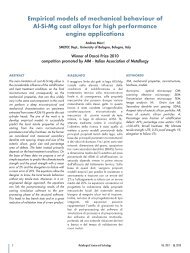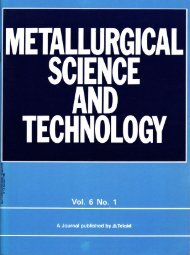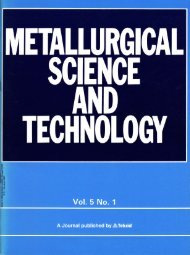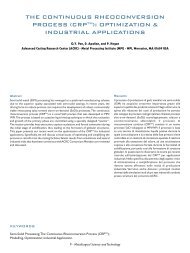PDF, about 5Mb - Teksid Aluminum
PDF, about 5Mb - Teksid Aluminum
PDF, about 5Mb - Teksid Aluminum
You also want an ePaper? Increase the reach of your titles
YUMPU automatically turns print PDFs into web optimized ePapers that Google loves.
according to the ASTM E1820 standard. As far as<br />
the AA2618 alloy that resulted to be the toughest<br />
material at room temperature, at 130°C it showed<br />
unstable crack propagation (Figure 3b) that<br />
prevented the evaluation of J IC. In the cases of valid<br />
J IC , K JIC was computed, assuming plain strain<br />
conditions, by using the following correlation<br />
proposed by ASTM E1820 standard:<br />
3.3. FRACTOGRAPHIC<br />
OBSERVATIONS<br />
Fractographic observations were performed at<br />
two main locations on fracture surface of each<br />
specimen in the crack propagation region: the first<br />
next to, the latter at 4 mm from the boundary<br />
with fatigue precrack. Selected images at low<br />
magnification of the first location for the different<br />
alloys and specimen orientation are reported in<br />
figure 4. In the unstable crack propagation region,<br />
the 2014-A forging showed the typical features of<br />
ductile fracture, generated by nucleation of dimples<br />
mainly from the coarser intermetallic particles<br />
fractured in a brittle way (figure 5a). Within the<br />
matrix, regions with dimples of far smaller size<br />
were also visible, laying on well-defined planes<br />
A)<br />
C)<br />
K JIC = [(E/(1-v 2 ))•J IC ] 0.5 (4)<br />
K JIC values are also listed in Table 2 for comparison purpose. Examination of<br />
this table clearly shows that toughness of 2014-B forging is greater than<br />
that of the same alloy in forging 2014-A. Further, it can be stated that in all<br />
the examined samples, crack propagation in CL orientation is favoured<br />
with respect to that in CR orientation.<br />
(figure 5b). These can be correlated to the presence of fine particles that in<br />
some cases were observed inside the dimples in high magnification images<br />
that suggest ductile intergranular fracture.<br />
The fracture surfaces of the 2014-B forging did not show significant<br />
differences from 2014-A material, with relatively extended regions of<br />
microdimples (figure 7a) that could be correlated to the presence of coarse<br />
grain boundary particles (figure 6b). The size and distribution of these<br />
particles corresponded to those observed at grain boundaries (figure 4c).<br />
The 2618 forging, showed a transgranular ductile fracture mode (figures<br />
4d, 7b). Dimples observed on fracture surfaces nucleated from the<br />
homogeneously distributed FeNiAl 9 particles (figures 6c and 6d).<br />
The fracture surfaces of specimens tested at 130°C of forgings made of<br />
AA2014 alloy were similar to those tested at room temperatures (figure<br />
8a). On the contrary, as the temperature increased, small-size microdimples<br />
were observed on the fracture surface of the forging made of AA2618 alloy<br />
(compare figure 7b and 8b).<br />
Fig. 4: Fracture surface of cracks propagated at room temperature in the boundary region between fatigue precracking and unstable crack<br />
propagation region. 2014-A forging, CL (a) and CR (b) directions. 2014-B forging; CR direction (c) and 2618, CR direction (d).<br />
B)<br />
D)<br />
8 - Metallurgical Science and Technology







